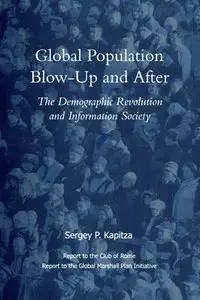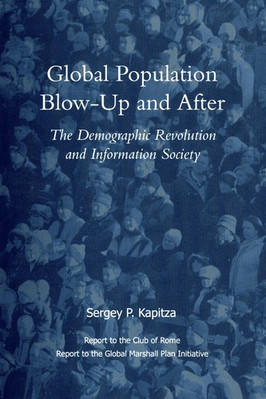"Global Population Blow-up and After: The Demographic Revolution and Information Society" by Sergey P. Kapitza
Report to the Club of Rome. Report to the Global Marshall Plan Initiative
GMP | 2006 | ISBN: 3980972356 9783980972352 | 273 pages | PDF | 5 MB
Report to the Club of Rome. Report to the Global Marshall Plan Initiative
GMP | 2006 | ISBN: 3980972356 9783980972352 | 273 pages | PDF | 5 MB
The development of a quantitative nonlinear theory of the world population is of interest for interdisciplinary research in anthropology and demography, history and sociology, for population genetics and epidemiology, for studies in evolution of humankind and the origin of man. The model also provides insight into the stability of growth and the present predicament of humankind, and provides a setting for discussing the main global problems.
What will the future of Europe look like?
Will it be a common future or will there be different futures in old member states, new member states and those countries which are left outside the European Union?
Will Europe take up the challenge of the limits to growth of resource consumption?
Will it be the continent where decoupling of further growth of GDP from resource use can be achieved?
Or will there be no future for an ageing continent with a shrinking and less and less innovative population?
How can science, how can a new futurology help to overcome the problems ahead?
Of all global problems world population growth is the most significant. Demographic data describe this process in a concise and quantitative way in its past and present. Analysing this development it is possible by applying the concepts of systems analysis and synergetics, to work out a mathematical model for a phenomenological description of the global demographic process and to project its trends into the future.
Contents
Foreword by the President of the Club of Rome
Foreword by Professor Franz Josef Radermacher
Preface
1. Introduction
1.1. Global Population Growth
1.2. Dynamical Approach to Social Studies
1.3. The Statistical Nature of the Demographic Problem
1.4. From a Qualitative Description to a Quantitative Analysis
1.5. Population Explosion and the Demographic Transition
1.6. Models in Demography
1.7. The Complexity of Systems and Aggregating Data
2. Global Population as a System
2.1. The Physics of Systems
2.2. Stability and Self-Organization in Systems
2.3. The World of Non-linear Systems
2.4. Interactions in the Population System
2.5. Mankind as a Social Species
2.6. Components of Growth
3. Modeling World Population Growth
3.1. Principles of Modeling
3.2. Linear and Exponential Growth
3.3. Hyperbolic Population Growth
3.4. The Law of Quadratic Growth
3.5. Informational Nature of Growth
4. Population Growth and the Model
4.1. The First Steps of Mankind
4.2. Influence of Climate and Geography
4.3. Global population since the Neolithic
4.4. The Number of People Who Have Ever Lived
4.5 The Future Population of the World
5. The Sense of Time in History
5.1. Transformation of Time
5.2. Transforming the Time of History
5.3. The Beginning of the Scale of Time
5.4. Synchronism of Global Development
5.5. Concept of Time in History
6. The Global Interaction
6.1. The Nature of the Interaction
6.2. Isolated Communities
6.3. Hierarchy of Demographic Structures
6.4. Globalization and Development
6.5. Socioeconomic Cycles of Development
7. The Demographic Transition
7.1. Nature of the Demographic Transition
7.2. The Global Transition
7.3. Processes During the Transition
7.4. Changes in the Age Distribution
7.5. Transition and the System's Approach
7.6. Models and Theories of Demographic Processes
8. Stability of Growth
8.1. Stability of the Demographic System
8.2. History in Terms of Stability
8.3. Global Security in the Future
9. Resources, Energy and Population
9.1. The Open Model and the Population Imperative
9.2. Energy and the Population Growth
9.3. The Environment
9.4. Do Resources Limit Growth?
9.5. Distribution of Population in Space
9.6. Distribution of Wealth in the Global System
9.7. Growth of a Knowledge Economy and Culture
10. The World of the Future
10.1. Concluding remarks
10.2. Interdisciplinary Research and Demographic Policy
10.3. Global Development at Large
10.4. The New World — Stabilized and Old
Appendix.
The Mathematical Theory of Global Population Growth.
A.1. The Demographic Problem
A.2. The Case of Quadratic Growth
A.3. Defining the Model and Excluding the Singularities
A.4. Dimentionless Variables of Time and Population
A.5. The Limit of Population and the Number of People Who Ever Lived
A.6. Asymptotic Solutions and Autonomous Equations
A.7. Dynamic Stability of Growth
A.8. Structure of Time and Demographic Cycles
A.9. Scaling Urban Population and Fluctuations
List of Figures
List of Tables
References
Name Index
Subject Index
Index of Countries
Global Marshall Plan Initiative
with TOC BookMarkLinks



